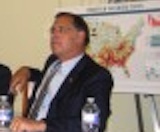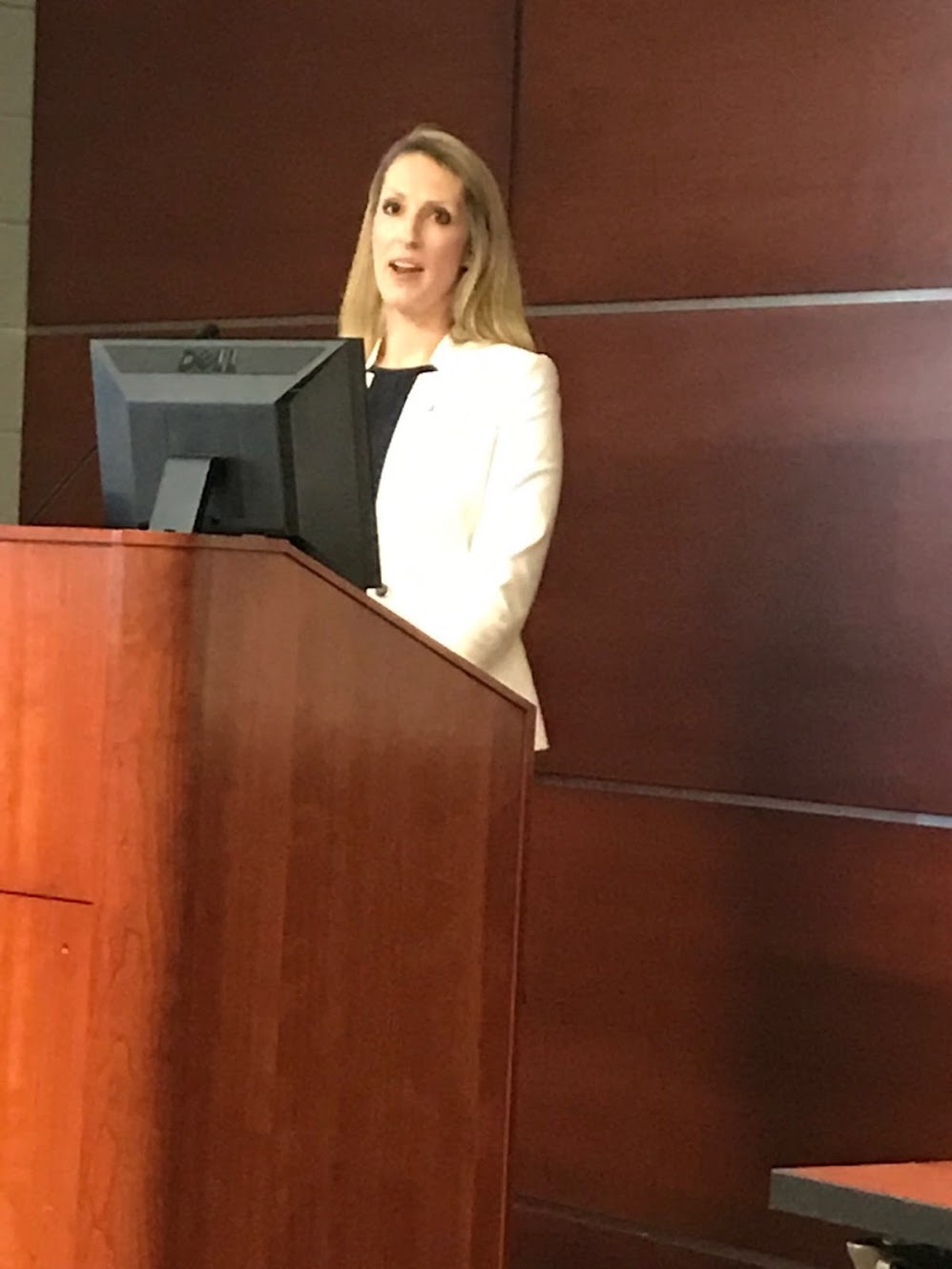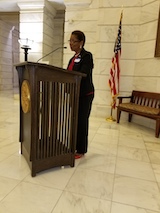Economic Equality Caucus
which advocates for economic equality across the USA.
| Home | Organizational Structure | State Coordinators | Executive Director | Caucus Articles | Memberships | |||||
| "Delta Vision, Delta Voices" | ||||||||||
|
Help Advocate for Economic Progress and Equality. Donate to the Delta Caucus/Economic Equality Caucus. |
||||||||||
Delta Grassroots Caucus Events

Credit Michael Hibblen/ KUAR News, Arkansas Public Radio; Former President Bill Clinton speaking to the Delta Grassroots Caucus on May 2, 2013, at the University of Arkansas Clinton School of Public Service, Little Rock

U. S. Senator John Boozman, Arkansas, at a Delta Grassroots Caucus meeting at the US Capitol

Brad Cole, Executive Director of the Municipal League of Illinois; previously a senior aide to former Republican US Sen. Mark Kirk of Illinois, earlier Mayor of Carbondale, Illinois, veteran Delta regional advocate, speaking at the Delta regional conference in West Memphis, Arkansas on April 26, 2019.

President Bill Clinton makes a comment to Delta Caucus Director Lee Powell at a meeting in Blytheville, Arkansas (in the northeast Arkansas Delta) on Nov. 2, 2014

The Delta Caucus would like to pay tribute to the late, great U.S. Sen. Thad Cochran of Mississippi, a powerful force in the US Senate for decades and a champion for the Delta. Sen. Cochran passed away on May 30, 2019. He spoke to the Delta Caucus on many occasions over the years (he is pictured above speaking to a Caucus event on Capitol Hill in Washington, DC) and his thoughtful, courteous and bipartisan leadership will be sorely missed.

Marcie Lawson, Executive Director, Sikeston, Missouri Regional Chamber and Area Economic Development Corporation, speaking at the Delta regional conference in West Memphis, Arkansas on April 26, 2019.

Alan Gumbel, Greater Memphis Alliance for a Competitive Workforce, Memphis, Tennessee, speaking at the Delta regional conference in West Memphis, Arkansas on April 26, 2019.

Mayor Shirley Washington of Pine Bluff, AR, speaking to the Delta Caucus at the Arkansas Capitol Rotunda in 2017.
USDA Nutrition Appropriations Update: Most Programs Fared Relatively Well
Posted on December 08, 2011 at 12:52 PM
The 2012 Agriculture Appropriations bill that became law on Nov. 18 included increases in Supplemental Nutrition Assistance Program (SNAP) benefits, school meal programs, and overall was a positive result that will enhance food security and boost our weak economy in the Delta.
Federal nutrition programs are vital for our region, which unfortunately ranks at the bottom in food insecurity, obesity and other nutrition-related issues. Most actions coming out of Washington this year have been failures, so this was a positive exception to that rule.
Considering the proposals earlier in the year made in Washington calling for cuts to SNAP, the TEFAP program that aids food banks, and other vital nutrition programs, this result is clearly more constructive than negative, and it is a relief to have some positive news in an otherwise bleak economic situation.
It was not all positive–for examples, there was an unwise if relatively small cut in the Women, Infants and Children nutrition program, and a pointless, counterproductive reduction in the small but meritorious WIC Farmers Market Nutrition Program that helps small farmers and provides nutritious fruits and vegetables to many people.
On the whole, however, most USDA nutrition programs fared well and we want to thank all of our partners in Congress, USDA, and grassroots leaders in the Delta states for all their hard work in getting out the message about the tremendous value of these programs in fighting hunger and boosting the economy.
Recent data from the Food Research Action Center and other anti-hunger organizations underscore the importance of USDA nutrition programs: SNAP benefits not only fight food insecurity and hunger, but one dollar spent on SNAP increases Gross Domestic Product from $1.73 to $1.79, according to Moody’s Analytics.
The Congressional Joint Economic Committee (JEC) recently reported that an increase of $1 billion in SNAP (formerly known as food stamps) spending generates 17,900 jobs. We must oppose any efforts to cut programs like SNAP that fight hunger and help create jobs.
On another note: PLEASE SAVE THE DATES OF MAY 3-4, 2012 FOR THE ANNUAL DELTA CONFERENCE AT THE CLINTON PRESIDENTIAL CENTER IN LITTLE ROCK, which will include hunger and nutrition and other key Delta issues. The opening session is Thursday evening, May 3, from 5 p.m. to 8 p.m. at the Clinton School of Public Service, and then we meet on Friday, May 4, from 8:30 a.m. to 3:15 p.m. at the Clinton Library Great Hall.
The group hotel is the Comfort Inn & Suites at the Clinton Library. To get the reduced group rate of $82 a night for May 3-4, just call the hotel at 1-501-687-7700 and say you are with the Delta Caucus. Deadline to get the group rate is April 20, 2012.
The Delta unfortunately ranks at or near the bottom in hunger, food insecurity and poverty statistics. This fall’s USDA food insecurity data indicated that the Delta had three of the five worst states regarding access to nutritious, affordable food: Mississippi’s food insecurity rate was 19.4 %, Arkansas was the third worst at 18.6%, Alabama at 17.3%. Louisiana fared somewhat better but still had 12.6%. Similarly, Mississippi, Kentucky and Alabama had three of the worst poverty rates.
The JEC’s Nov. 22, 2011 report entitled, “Lifeline for Families, Support for the Economy: The Supplemental Nutrition Assistance Program (formerly known as Food Stamps) pointed out the necessity of assuring that unemployed Americans have the best support system possible that provides them with some peace of mind while they continue to search for a job. Many long-term unemployed workers have run out of unemployment insurance benefits, and many more may exhaust their benefits soon.
SNAP benefits are particularly valuable for the long-term unemployed and their families, since the program is one of only a few sources of public support for those who have exhausted their unemployment benefits. More than one in five workers unemployed for over six months received SNAP benefits last year.
Rise in SNAP usage–One in seven Americans receives them: This is bad news when so many people have to use this program due to the weak economy, but we would be much worse off without SNAP. Food Research Action Center (FRAC), a leading national organization on hunger and nutrition, reported in early December, 2011 that in September 2011, SNAP/Food Stamps national participation rose to a record 46,268,257 people – an increase of more than 430,434 people compared with September 2010. One in seven Americans receives SNAP/Food Stamps.
According to FRAC, the share of the US population receiving SNAP is similar to the percentage of the U.S. workforce experiencing unemployment or underemployment.
In 2011, the recession was compounded by flooding and storms in the Delta, causing SNAP to have to respond further to the needs driven by natural disasters.
Despite the bleak economic picture, three in ten of all the people who are eligible to receive SNAP do not receive them. Implementing SNAP/Food Stamps policies that improve program access, ensuring staff capacity to process applications, and mounting outreach campaigns to get the word out to the public can help communities maximize the federal recovery dollars available to help local families and businesses.
Deterioration since 2000: The number of people participating in SNAP/Food Stamps in September 2011 was 28.9 million more persons than in July 2000, when program participation nationally reached its lowest point in the past decade (16.9 million individuals).
Benefits of SNAP documented by non-political, factual USDA Economic Research Service report: ERS made an objective study of the impact of the 2009 stimulus (the American Recovery and Reinvestment Act’s increases in SNAP benefit levels in Amber Waves: The Economics of Food, Farming, Natural Resources and Rural America, (USDA ERS, June 2011, pages 16 to 23, “Food Security of SNAP Recipients Improved Following the 2009 Stimulus Package,” ). Among the factual findings were the following:
The ERS study tracked the impact of increased benefit levels (for example, benefits for a family of four went up by $890), and provisions giving states an option to suspend provisions limiting how long some unemployed, working age participants could receive benefits.
After these enhancements, SNAP participation and inflation-adjusted food spending by low-income households increased and food insecurity declined by 2.2 percent among low-income households, but was unchanged among households with incomes somewhat above the cutoffs for SNAP eligibility.
For struggling families, SNAP is making a huge difference on their economic well-being and health. Reports from the U.S. Census Bureau and USDA’s Food and Nutrition Service (FNS) show that SNAP benefits lift people out of poverty. Nationwide, SNAP benefits lifted 3.9 million people above the poverty line in 2010.
Congress passed a $130.4 billion measure that funds five Cabinet departments, cuts programs that send cash to local government agencies, supports law enforcement and programs funneling money directly to voters, and adds money to federal nutrition programs. SNAP/Food Stamps gets $12 billion more, and the school lunch program budget is increased as well. “The good thing is that – in a time when more and more people need school breakfast and school lunch and the other programs – Congress is meeting that need,” said Jim Weill, president of the Food Research and Action Center.
On Nov. 18, 2011, President Obama signed the 2012 Agriculture Appropriations bill into law.
On Nov. 14, the Senate and House Appropriations Conferees released a first set of spending bills (being called a “minibus” rather than an “omnibus”). It includes FY2012 funding for the Departments of Agriculture, Commerce, Justice, Transportation, and Housing and Urban Development. The bill also includes a new continuing resolution (CR) that will keep other government programs funded through December 16.
The bill provides a total of $136.6 billion for USDA programs. Nutrition program funding includes:
SNAP/Food Stamps: $80.4 billion (FY2011 funding was $65.21 billion)
SNAP Reserve Fund: $3 billion (FY2011 funding was $3 billion)
Child Nutrition Programs: $18.15 billion (FY2011 funding was $17.32 billion)
National School Lunch Program (NSLP): $10.17 billion (FY2011 funding was $9.98 billion)
School Breakfast Program: $3.32 billion (FY2011 funding was $3.09 billion)
Child and Adult Care Food Program (CACFP): $2.83 billion (FY2011 funding was $2.69 billion)
Summer Food Service Program: $402 million (FY2011 funding was $392.68 million)
Women, Infants and Children (WIC) nutrition program: $6.6 billion (FY2011 funding was $6.73 billion)
Commodity Supplemental Food Program: $176.8 million (FY2011 funding was $175.7 million)
The Emergency Food Assistance Program (TEFAP) Commodities: $260.25 million (FY2011 funding was $248 million)
The Emergency Food Assistance Program (TEFAP) Admin (storage/transportation): $48 million (FY2011 funding was $49.4 million)
WIC Farmers Market Nutrition Program: $16.5 million (FY2011 funding was $19.96 million)
Senior Farmers Market Nutrition Program: $20.6 million (same as FY2011)
Nutrition Programs Administration: $138.5 million (FY2011 funding was $147.51 million)
Congressional Hunger Center: $2 million (FY2011 funding was $1.27 million)
McGovern-Dole International Food Program: $184 million (FY2011 funding was $199.5 million)
School Breakfast Program Grants: $1 million (not authorized in FY2011)
Farm to School: $2 million (not authorized in FY2011)
Hunger Free Communities Grants: No funding was provided. (not funded in FY2011; FY2010 funding was $5 million)
TEFAP Infrastructure Grants: No funding was provided. (not funded in FY2011; FY2010 funding was $6 million)
USDA Obesity Prevention Research Unit maintained: We understand that the USDA Delta Obesity Prevention Research Unit will have a budget of approximately $3.8 million. We had several USDA nutrition experts speak at our conference in Washington, DC and are glad that this excellent program is continuing.
As Dr. Margaret Bogle of USDA ARS (based in Little Rock, AR) was quoted as saying in the Delta Caucus spending priorities plan demonstrated at the Washington, DC conference in November, 2011, the Delta unfortunately leads the nation in obesity rates. Obesity in the Delta hampers health and this leads to economic damage in increased health care costs and loss of productivity in the workplace.
The Delta Obesity Prevention Research Unite employed over 200 individuals in the Delta of Arkansas, Louisiana and Mississippi for its research through cooperative agreements with eight universities and two small minority business owners in Jackson, Mississippi who assisted in the research. Any activity that helps put people to work is a plus in today’s economy.
Progress in Enhancing SNAP Program Integrity and Fighting Fraud
Over the years there has been substantial progress in eliminating waste and abuse in the SNAP/food stamps program. Trafficking only diverts about 1 cent for every benefit dollar issued. The trafficking rate has fallen significantly over the last two decades, from about 4 cents on the dollar in 1993 to about 1 cent in 2006-08.
Of course, any waste should be eliminated and USDA is wisely staying vigilant in utilizing new tools and tactics to continue to reduce the rate of trafficking. On Dec. 6, 2011, USDA Under Secretary for Food, Nutrition and Consumer Services Kevin Concannon hosted a national media conference call to announce a new range of aggressive tactics to further improve integrity in USDA’s Supplemental Nutrition Assistance Program (SNAP) – formerly known as food stamps. The announcement directly supports the administration’s Campaign to Cut Waste and highlights efforts to root out waste, fraud and abuse in federal spending so taxpayer dollars are invested wisely. The new tactics underscore USDA’s unprecedented approach to combating trafficking – the sale of SNAP benefits for cash.
AS USDA emphasized in a Dec. 6 statement, “While a relatively limited problem, no level of trafficking or other crime is acceptable or tolerated by USDA. The department uses all available resources – from state-of-the-art technology to undercover investigations – to reduce and prevent trafficking and prosecutes abuses to the fullest extent of the law.”
Thanks again to all of our colleagues for their hard work on hunger and nutrition issues in the Delta. Lee Powell, MDGC (202) 360-6347
Back to the top